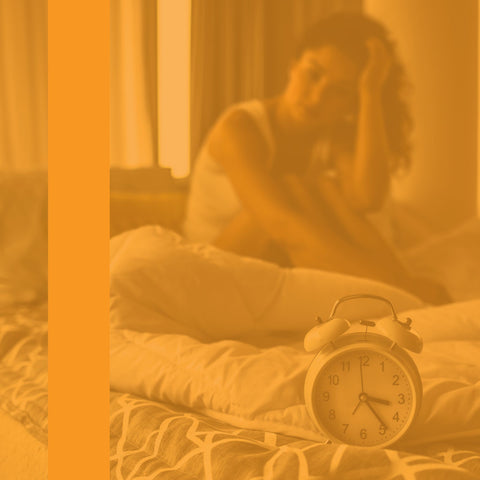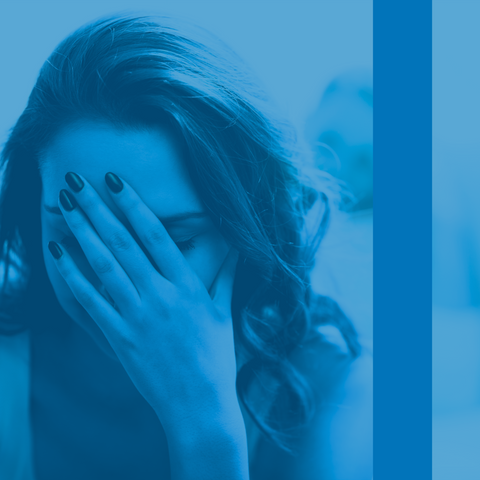
Here at Troscriptions, we are big fans of all things GABA and have already published an in-depth guide that you can read here.
However, if you don’t have time to read the whole guide and are looking for ways to increase GABA naturally, here is a quick summary:
GABA stands for gamma-aminobutyric acid (which is an amino acid) and is arguably the most important inhibitory neurotransmitter in our brain. When we talk about the GABAergic function, we are referring to the relaxation effects that happen through GABA and its receptors in the brain.
GABA is synthesized from glutamate and needs vitamin B6 to make that happen [1]. Foods with high levels of glutamate that will help your body produce more GABA include dairy, meat, seafood, and mushrooms.
GABA has a positive effect on sleep quality, anxiety, and stress [2], it protects the brain and decreases blood pressure [3], improves memory as well as other cognitive functions [4].
In this article, we are going to focus on 7 ways to naturally increase GABA in the brain, including cool tech and some awesomely therapeutic orange and lavender troches!
1. Yoga and GABA: Promote Relaxation Through Meditation and Yoga Practices
Meditation improves attention, cognitive performance, and emotional regulation by increasing activation of the prefrontal cortex and stimulating the reticular nucleus of the thalamus, which is involved in GABA production and release [5].
The type of meditation is entirely your choice! It can be mindfulness, loving-kindness, transcendental, or vipassana meditation; guided or unguided; using an app, music, or just in silence. Even walking or standing meditation will do the trick. Regardless of the type of meditation, the one that will give you the most benefits is the one that you will actually do. If you want to learn more about meditation and GABA, don’t miss this article.
Yoga can help too! In experienced yoga practitioners, GABA levels in the brain increase right after practice, and yoga is even considered a treatment for disorders with low GABA levels such as depression and anxiety [6].
For example, a 12-week yoga practice improves mood and decreases anxiety even more than walking exercises by increasing GABA in the thalamus [7].
Yoga and GABA go hand in hand, and there are many types of yoga to choose from. You can practice Hatha, Iyengar, ashtanga, Bikram yoga, acro-yoga, aerial yoga, or any kind that resonates with you.
2. Exercise Can Increase GABA Naturally and Positively Affect GABA Function
Scientific studies assessed the effects of physical activity on neurophysiological measures of inhibition or relaxation. In the prefrontal cortex, the inhibitory effect of exercise is largely mediated by the activation of GABA receptors [8].
Physical exercise is also a low-cost and effective way to increase GABA and manage chronic pain through GABAergic mechanisms. It can even reduce the dosage of drugs used to treat pain and eventually lessen their side effects [9].
Nerd time! As physical exercise lowers stress and anxiety, scientists wanted to understand the role of GABA in these effects. So they studied rats with free access to a running wheel for 4 weeks and saw that long-term voluntary exercise enhances forebrain GABA synthesis capacity in a region-specific manner. They concluded that regular exercise changes the forebrain’s GABAergic system, which can influence stress sensitivity and emotionality [10].
Aerobic exercises such as running, cycling, swimming, or dancing all increase GABA levels and enhance GABAergic neurotransmission, improving mood and reducing stress.
So if you were about to skip today’s training session, you might want to think twice!
3. Sleep Optimization Can Directly Enhance GABA Function
GABA levels tend to increase during sleep, contributing to sleep induction (i.e. our ability to fall asleep) and maintenance. GABAergic neurons suppress wake-promoting neurotransmitters such as histamine and norepinephrine and, at the same time, promote the release of sleep-promoting neurotransmitters such as serotonin and melatonin.
Enhanced GABAergic activity during sleep also slows down brain activity and reduces arousal, which promotes deep and restorative sleep as well. Conversely, sleep deprivation or disturbances can disrupt the balance of GABA, leading to reduced GABAergic function and increased neuronal excitability. This can contribute to difficulty falling asleep, fragmented sleep, and decreased overall sleep quality. Therefore, having good sleep hygiene is crucial for optimal GABAergic function [11].
There are many things that you can do to improve sleep and increase levels of GABA. Examples include turning off screens and bright light at least one hour before going to sleep (ideally after sunset), using f.lux on your computer and a nighttime filter on your phone, replacing light bulbs at home or using blue light-blocking glasses, and making sure your room is cold and as dark as possible. This is basic sleep hygiene that your body needs for a good night's rest, but there is always more you can do!
Check out this article if you’d like to know more about sleep hormones and how they affect the GABA system.
4. The Tech: Transcranial magnetic stimulation (TMS) and vagus nerve stimulation (VNS) to Increase GABA
Transcranial magnetic stimulation (TMS) is a non-invasive neurostimulation technique that delivers magnetic pulses through an electromagnetic coil placed on the scalp, which stimulates or inhibits specific regions of the brain. TMS can be used to increase GABA release and improve GABAergic neurotransmission. It can even promote neuroplasticity.
While extensive research is still needed to understand the mechanisms behind it, TMS can potentially be used as a treatment for neurological and psychiatric disorders, including depression, OCD, and migraines. The downside is that TMS requires specialized equipment and is typically administered in a clinical setting under the supervision of a healthcare professional [12].
In addition to TMS, another technique called vagus nerve stimulation (VNS) can increase the tone of the nervous system responsible for relaxation (also called the parasympathetic nervous system or rest-and-digest mode).
While in a clinical setting, VNS is considered an invasive technique in which a device is surgically implanted inside the body, transcutaneous VNS (tVNS) involves applying mild electrical stimulation to the skin over the ear or neck regions. tVNS delivers electrical stimulation through surface electrodes applied to the skin, transmitting the electrical current through the tissue to vagus nerve branches. However, the stimulation is generally weaker and more diffused compared to TMS. tVNS is a new technique that has shown promise in treating conditions such as epilepsy, depression, anxiety, chronic pain, and inflammatory disorders.
The advantage of tVNS is that it can be administered through small, portable devices that can be used at home or on the go. It is generally considered safe for self-administration after appropriate training and guidance [13,14].
5. Foods that Increase GABA and Optimize GABA Function
Certain dietary factors can influence GABA levels. Foods rich in glutamate, such as green tea, spinach, and nuts, may promote GABA synthesis. Additionally, supplements like magnesium, vitamin B6, and L-theanine have been suggested to support GABA function as well.
Quick side note: When possible, it’s essential to detect and correct deficiencies (such as amino acid deficiencies) to optimize nutrition, lifestyle, and supplementation. For more information on this, go to homehope.org and learn about our nonprofit organization which is training doctors and practitioners on how to optimize health rather than just treat disease!
Magnesium is known to play a crucial role in the regulation of the GABAergic system in the brain as it acts as a cofactor in the enzymatic reactions that facilitate GABA synthesis. Additionally, magnesium can modulate GABA receptors, enhance their sensitivity to GABA, and increase its inhibitory effects in the brain. Adequate magnesium levels are essential for maintaining a healthy GABA balance. Magnesium may also modulate anxiety via increasing GABAergic availability and by decreasing presynaptic glutamate release [15].
Vitamin B6 (aka pyridoxine) is essential for the conversion of glutamate to GABA; therefore, optimized vitamin B6 supplementation ensures that all available glutamate can be effectively converted to GABA.
Certain natural substances can indirectly support GABA function too. For example, L-theanine, which is commonly found in green tea, helps promote a sense of calmness by increasing GABA levels in the brain. Passionflower extract, valerian root, and chamomile are also known for their effects on GABA, providing relaxation and alleviating stress.
Also, ashwagandha or Withania somnifera, an adaptogenic plant, may confer modest benefits in certain neuropsychiatric conditions. Its benefits may arise from the induction of neuroplasticity, antioxidant and anti-inflammatory effects, and modulation of GABA and glutamate, as well as other neurotransmitters [16].
6. Supplements to Increase GABA Naturally
GABA supplements for sleep or anxiety are widely available online. Although many consumers claim they feel their benefits, it is still unclear if these supplements to increase GABA provide more than a placebo effect, as the mechanism of action of these products is still unknown.
It has long been thought that GABA cannot cross the blood-brain barrier (BBB); however, even these studies are contradictory and don’t clearly establish if oral GABA administration reaches the human brain. Some of the observed effects may be indirect, via the enteric nervous system [17].
As you hopefully remember from the start of this article, GABA comes from glutamate and needs vitamin B6 to do the trick. In contrast to GABA, glutamate can cross the BBB and reach the brain, where it can be converted to GABA.
Interestingly, there is a way to help GABA get into the brain. Niacin (aka nicotinic acid or vitamin B3) bound to GABA creates a molecule called N-nicotinoyl-GABA, which helps GABA cross the BBB by increasing both B3 and GABA levels in the brain. Needless to say, this combination works magically to reduce stress and anxiety. You can read more about N-nicotinoyl-GABA here!
Moreover, Piper methysticum or kava, is widely consumed by the indigenous peoples in the islands of the South Pacific. Kava is thought to work by increasing the binding of GABA; therefore, with more GABA bound, the brain fires less and calms more [18].
The pharmacological properties of the kavalactones (the active part of kava) are thought to block voltage-gated sodium ion channels, increase ligand binding to GABA type A receptors, decrease excitatory neurotransmitter release due to calcium ion channel blockade, reduce neuronal reuptake of noradrenaline, facilitate reversible inhibition of monoamine oxidase B and suppression of the synthesis of the eicosanoid thromboxane A(2) which antagonizes GABA(A) receptor function, and more[19]. Read more about kava here!
Finally, the endogenous cannabinoid (eCB) system is linked to the major excitatory (glutamatergic) and inhibitory (GABAergic) neurotransmitter systems in the brain. The major non-intoxicating component of cannabis, cannabidiol (aka CBD) has been extensively studied as a treatment for mental health and neurodevelopmental disorders. CBD modulates brain excitatory glutamate and inhibitory GABA levels. While further research is still needed, studies have shown that CBD increases GABA and modulates glutamate-GABA systems [21].
The interaction of CBD with the eCB, glutamatergic, and GABAergic systems is not yet fully understood. Studies show that CBD can act as a positive allosteric modulator of the GABAAR to increase inhibitory tone [22], but more research is yet to come.
To learn more about how CBD affects GABA, take a look at this article!
7. Bonus Track: Tro Zzz, Tro Calm, and Carry On
Speaking of effective ways to naturally increase GABA in your brain, you might want to consider two superb options that have been carefully calibrated by the 4 physicians at Troscriptions — Tro Zzz and Tro Calm.

Tro Zzz is more than just a sleep aid – it's our buccal troche that utilizes the collective power of science, nature, and your GABA system to deliver the restful sleep you've been dreaming of. Imagine the ability to effortlessly drift into a peaceful slumber, night after night, and wake up feeling revitalized and prepared to take on the day. Not only does it aid in falling asleep faster, but it also ensures that you stay asleep longer, and if you happen to wake up, you can easily fall back asleep. With Tro Zzz, you wake up with renewed vitality, ready to seize the day.
On the other hand, if your day-to-day life is burdened by stressors and anxiousness, Tro Calm is your go-to companion. In our fast-paced world, stress and anxiety have sadly become the new normal. It's time for a pause, don't you think?
Tro Calm is our precision-dosed and physician-formulated buccal troche that will help you take the edge off, chill out, and quiet your mind. It's designed to alleviate stress and reduce anxiousness while promoting calm productivity and focus. All 4 ingredients directly or indirectly modulate the brain’s GABAergic system.
Tro Calm contains N-nicotinoyl-GABA, which crosses the BBB and increases GABA directly (unlike GABA supplements), and kava, which increases the binding of GABA to its receptors. It also contains CBD and CBG, which modulate the endocannabinoid system and the GABA system.
At low doses, the ingredients in Tro Zzz and Tro Calm work synergistically and safely without risk of dependence or tolerance when used as directed. But remember, these are not magical quick fixes. They are effective tools that can help you now along your path to optimal health.
Summary
What is GABA? Unmasking your Brain's Unsung Hero
As an inhibitory neurotransmitter, GABA is like that cool yoga instructor, guiding your overexcited neurons to breathe in, chill out, and slow down their rapid-fire messages. Think of it as nature's own Xanax, on hand 24/7 to dial down your brain's noise and maintain harmony.
GABA benefits your brain in more ways than one. It's like your brain's traffic cop, controlling the speed of information flow through your nervous system and putting the brakes on when things get too hectic. It is essentially our brain's equivalent to a soothing lullaby, toning down overstimulation, and fostering tranquility. Whether it's taming anxiety, managing sleep disturbances, or simply ushering in a sense of calm, GABA steps up. So, if your mind's racing like it's in Formula One, just remember, GABA's got the wheel.
By the way, GABA is also a firm believer in self-improvement, dialing up its game with help from foods that increase GABA, certain lifestyle changes, and supplements that increase GABA. But remember, optimizing your GABA levels isn't just about popping supplements or loading up on certain foods, it's a holistic journey.
GABA Benefits: The Advantages of Healthy GABA Levels in Your Body
This neurotransmitter doesn't just keep your neurons humming in harmony, it's got a whole slew of other benefits up its sleeve. Here are some of the GABA benefits and advantages you can expect if you take supplements to increase GABA or are looking to boost GABA levels naturally:
- May improve mental health: From silencing the persistent chatter of anxiety to lifting the heavy curtains of depression, GABA's got your back. It's like your brain's own little therapist, helping to keep those mental health demons at bay.
- Can help with chronic pain: It's no secret that dealing with chronic pain can be a real drag. But here's some good news - GABA steps into the ring and wrestles down those persistent aches, possibly making life a little bit more bearable.
- Supports a healthy sleep: If counting sheep isn't cutting it for you, GABA might just be the ticket to the dreamland you've been waiting for. By helping to promote a deep, restful sleep, it helps you wake up refreshed and ready to seize the day.
- May stimulate the circulatory system: This neurotransmitter is like a little plumber for your circulatory system, helping to keep that blood pressure in check and ensuring everything flows just right.
- Might help with PMS: Ladies, we've all been there. PMS can be a real party crasher, but GABA's here to save the day, helping to alleviate those pesky symptoms.
So, the next time you're feeling out of sorts, remember — your brain's got a secret weapon, and it goes by the name of GABA.
GABA Deficiency: The Effect of Insufficient GABA Levels in the Brain
Unfortunately, there are situations where GABA, our brain's resident peacekeeper, falls short. We're talking about a GABA deficiency. It's like an unwelcome party guest, triggering anxiety, panic attacks, mood disorders, and even seizure disorders. Not to mention it's cozying up to your local pub, contributing to alcohol-related problems.
What's more, just like a pesky gene that makes you prone to sunburn, genetics can make you prone to GABA deficiency. If anxiety runs in your family, there's a chance GABA deficiency might be sprinting right alongside it. Then there's the role of diet and stress. Poor nutrition and early life stress act like the bullies of the playground, pushing GABA down and keeping it there.
Now, you might think, "Can't we just pop a pill and fix this?" Well, in theory, yes. Supplements to increase GABA like benzodiazepines or the Troscriptions troches do exist, swooping in to treat sleep disorders, alcohol withdrawal, anxiety, and more. But keep in mind, these aren't miracle instant solutions, but rather aids that help you regulate your GABA levels more effectively.
Natural Ways To Increase GABA and Restore Your Brain's Blissful Balance
With GABA, you've got a powerful ally in fostering tranquility and combating the cacophonies of everyday life. Its multifaceted benefits, from promoting mental wellness to regulating sleep, make it a crucial part of your brain's ensemble. And the best part? Boosting your body’s GABA levels doesn't have to be a daunting task. Through a blend of mindful practices like regular exercise, adequate sleep, and nutritious food, you can naturally summon more of this inhibitory superstar.
But if you're looking for a little extra help, we've got you covered. Our Tro Calm and Tro Zzz products are engineered with your well-being in mind, offering a precision-dosed, pharmaceutical-grade solution to fortify your brain's GABA system. So don't wait any longer — embrace the journey of well-being, and tap into the magic of GABA today with Tro Calm and Tro Zzz. Your brain will thank you for it!
References
[1] Jewett BE, Sharma S. Physiology, GABA. NCBI Bookshelf 2022. https://www.ncbi.nlm.nih.gov/books/NBK513311/.
[2] Hepsomali P, Groeger JA, Nishihira J, Scholey A. Effects of oral gamma-aminobutyric acid (GABA) administration on stress and sleep in humans: A systematic review. Frontiers in Neuroscience 2020;14. https://doi.org/10.3389/fnins.2020.00923.
[3] Ngo D-H, Vo TS. An Updated Review on Pharmaceutical Properties of Gamma-Aminobutyric Acid. Molecules 2019;24:2678. https://doi.org/10.3390/molecules24152678.
[4] Kimura M, Hayakawa K, Sansawa H. Involvement of γ-Aminobutyric Acid (GABA) B Receptors in the Hypotensive Effect of Systemically Administered GABA in Spontaneously Hypertensive Rats. Japanese Journal of Pharmacology 2002;89:388–94. https://doi.org/10.1254/jjp.89.388.
[5] Meditation-Related Increases in GABAB Modulated Cortical Inhibition. Brain Stimulation n.d.;6:397–402. https://doi.org/10.1016/j.brs.2012.08.005.
[6] Streeter CC, Jensen JE, Perlmutter RM, Cabral HJ, Tian H, Terhune DB, et al. Yoga Asana Sessions Increase Brain GABA Levels: A Pilot Study. The Journal of Alternative and Complementary Medicine 2007;13:419–26. https://doi.org/10.1089/acm.2007.6338.
[7] Streeter CC, Whitfield TH, Owen L, Rein T, Karri SK, Yakhkind A, et al. Effects of Yoga Versus Walking on Mood, Anxiety, and Brain GABA Levels: A Randomized Controlled MRS Study. The Journal of Alternative and Complementary Medicine 2010;16:1145–52. https://doi.org/10.1089/acm.2010.0007.
[8] Levin O, Netz Y, Ziv G. Behavioral and Neurophysiological Aspects of Inhibition—The Effects of Acute Cardiovascular Exercise. Journal of Clinical Medicine 2021;10. https://doi.org/10.3390/jcm10020282.
[9] Senba E, Kami K. A new aspect of chronic pain as a lifestyle-related disease. Neurobiology of Pain 2017;1. https://doi.org/10.1016/j.ynpai.2017.04.003.
[10] Hill L, Droste S, Nutt D, Linthorst A, Reul J. Voluntary exercise alters GABAA receptor subunit and glutamic acid decarboxylase-67 gene expression in the rat forebrain. Journal of Psychopharmacology 2008;24:745–56. https://doi.org/10.1177/0269881108096983.
[11] Gottesmann C. GABA mechanisms and sleep - PubMed. Neuroscience 2002;111. https://doi.org/10.1016/s0306-4522(02)00034-9.
[12] Rogasch NC, Fitzgerald PB. Assessing cortical network properties using TMS–EEG. Human Brain Mapping n.d.;34:1652–69. https://doi.org/10.1002/hbm.22016.
[13] Yap JYY, Keatch C, Lambert E, Woods W, Stoddart PR, Kameneva T. Critical Review of Transcutaneous Vagus Nerve Stimulation: Challenges for Translation to Clinical Practice. Frontiers in Neuroscience 2020;14. https://doi.org/10.3389/fnins.2020.00284.
[14] McIntire LK, McKinley RA, Goodyear C, McIntire JP, Brown RD. Cervical transcutaneous vagal nerve stimulation (ctVNS) improves human cognitive performance under sleep deprivation stress. Communications Biology 2021;4:1–9. https://doi.org/10.1038/s42003-021-02145-7.
[15] Boyle NB, Lawton C, Dye L. The Effects of Magnesium Supplementation on Subjective Anxiety and Stress—A Systematic Review. Nutrients 2017;9. https://doi.org/10.3390/nu9050429.
[16] D’Cruz M, Andrade C. Potential clinical applications of Ashwagandha ( Withania somnifera) in medicine and neuropsychiatry - PubMed. Expert Review of Clinical Pharmacology 2022;15. https://doi.org/10.1080/17512433.2022.2121699.
[17] Boonstra E, de Kleijn R, Colzato LS, Alkemade A, Forstmann BU, Nieuwenhuis S. Neurotransmitters as food supplements: the effects of GABA on brain and behavior. Frontiers in Psychology 2015;6. https://doi.org/10.3389/fpsyg.2015.01520.
[18] Jussofie A, Schmiz A, Hiemke C. Kavapyrone enriched extract from Piper methysticum as modulator of the GABA binding site in different regions of rat brain - PubMed. Psychopharmacology 1994;116. https://doi.org/10.1007/BF02247480.
[19] Singh YN, Singh NN. Therapeutic potential of kava in the treatment of anxiety disorders - PubMed. CNS Drugs 2002;16. https://doi.org/10.2165/00023210-200216110-00002.
[20] Chua HC, Christensen ETH, Hoestgaard-Jensen K, Hartiadi LY, Ramzan I, Jensen AA, et al. Kavain, the Major Constituent of the Anxiolytic Kava Extract, Potentiates GABAA Receptors: Functional Characteristics and Molecular Mechanism. PloS One 2016;11:e0157700. https://doi.org/10.1371/journal.pone.0157700.
[21] Pretzsch CM, Freyberg J, Voinescu B, Lythgoe D, Horder J, Mendez MA, et al. Effects of cannabidiol on brain excitation and inhibition systems; a randomised placebo-controlled single dose trial during magnetic resonance spectroscopy in adults with and without autism spectrum disorder. Neuropsychopharmacology 2019;44:1398–405. https://doi.org/10.1038/s41386-019-0333-8.
[22] Osborne AL, Solowij N, Babic I, Lum JS, Newell KA, Huang X-F, et al. Effect of cannabidiol on endocannabinoid, glutamatergic and GABAergic signalling markers in male offspring of a maternal immune activation (poly I:C) model relevant to schizophrenia. Progress in Neuro-Psychopharmacology and Biological Psychiatry 2019;95:109666. https://doi.org/10.1016/j.pnpbp.2019.109666.






Comments (0)
There are no comments for this article. Be the first one to leave a message!